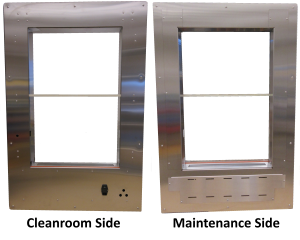Pass Through Windows 101: Applications and Uses
Pass through windows, also known as pass through chambers, are integral components in maintaining sterility, controlling environmental conditions, and enhancing operational efficiency in various controlled environments. These specialized installations are designed to facilitate the seamless transfer of materials between rooms without compromising sanitary conditions, temperature, or air quality.
This comprehensive guide explores the diverse types of pass through windows offered by Clean Room Devices, detailing their specific designs, features, and the wide range of industries they serve, including medical, pharmaceutical, commercial kitchens, and more.
Understanding Pass Through Windows
Pass through windows are openings in walls or barriers specifically designed to separate two different environments, typically where at least one is a controlled cleanroom or sterile area. Their primary purpose is to allow for the efficient transfer of materials, tools, or samples between these spaces without requiring personnel to enter, thus minimizing the introduction of contaminants.
Constructed with precision, these windows ensure an airtight seal when closed and often feature interlocking mechanisms that prevent both sides from being open simultaneously, further protecting against contamination. This design not only simplifies the transfer process but is crucial in maintaining the integrity of clean and sterile environments.
Manually-Opened Pass-Through Windows

Manually-opened pass through windows exemplify simplicity and effectiveness. Standard models measure 16 inches high by 24 inches wide, with an overall size of 48.75 inches high by 36 inches wide. They require a wall opening of 44.25 inches high by 31.5 inches wide, suitable for models CRD340/342 and CRD341/343.
Ideal for environments where manual control is preferred, these windows offer a durable and reliable mechanism for preventing cross-contamination, making them especially valuable in small-scale pharmaceutical labs, medical offices, and research facilities where the introduction of mechanical or electronic components may pose a contamination risk.
Material Conveyor Pass-Through Window Systems

For facilities that handle large or heavy items, material conveyor pass through window systems provide robust solutions to maintain cleanliness while transferring goods. These systems are equipped with built-in conveyors that facilitate the movement of items across controlled environments without direct physical handling by personnel.
Advanced features include sensors that automatically open the window when an object approaches, enhancing operational efficiency. These systems, compatible with models CRD320-326 and CRD330/336, can be installed with a conveyor on one or both sides, flush to the wall, providing seamless operation and compatibility with various industrial applications.
Electric Pass-Through Window with Shelves

Electric pass through windows with shelves optimize the transfer process through automated control. When a product is placed on the shelf, sensors trigger the windows to open and close automatically. These windows are available in models CRD310/311 and CRD315/316, with options for including an observation window. This automated mechanism reduces manual handling, thereby minimizing contamination risks and enhancing safety and operational speed in high-traffic environments such as hospitals and pharmaceutical plants.
Flush Mounted Pass-Through Windows

Designed for a seamless fit into the wall or clean room panel systems, flush mounted pass through windows provide a smooth, continuous surface that minimizes dust accumulation and microbial growth. Ideal for transferring materials between the clean room and packaging areas, these windows facilitate easy access and handling of materials and allow for the use of a counter on one or both sides.
Models CRD325 and CRD335 are specifically designed to maintain a flush surface, which is crucial for maintaining cleanliness in sensitive environments like biotechnology, pharmaceutical manufacturing, and microelectronics.
Diverse Industry Applications
Medical and Healthcare
In healthcare settings, pass through windows are essential for maintaining sterile pathways for surgical instruments, pharmaceuticals, and specimens. They significantly reduce traffic in sensitive areas, thus decreasing the likelihood of nosocomial infections and enhancing patient safety.
Pharmaceutical Manufacturing
These windows are critical in pharmaceutical manufacturing, protecting products from airborne contaminants during sensitive processes like compounding and packaging. They help maintain required ISO classifications for clean rooms, ensuring that products meet stringent regulatory standards.
Food Service
In the food service industry, pass through windows play a crucial role in efficiently managing the flow of ingredients and prepared dishes, especially in commercial kitchens and food processing plants. They improve service speed, maintain food safety, and reduce cross-contamination between raw and cooked foods.
Correctional Facilities
In correctional facilities, pass through windows ensure secure material transfer between different areas, helping control contraband and maintain hygiene in the distribution of food and medication.
Conclusion
Pass through windows are indispensable across sectors where cleanliness, efficiency, and contamination control are critical. With a variety of configurations such as manually-operated, conveyor-integrated, electrically-controlled with shelves, and flush-mounted designs, these windows are tailored to meet the specific needs of different industries.
By implementing the appropriate type of pass through window, facilities can optimize their operations and uphold the highest standards of cleanliness and safety.
As this versatile technology continues to evolve, it offers increasingly sophisticated solutions to meet the growing demands of modern industry practices, ensuring both operational excellence and compliance with health and safety regulations.